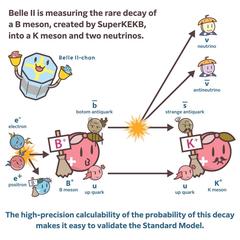Artistic interpretation of the new decay seen by Belle II. Image: HiggsTan
Even in the world of elementary particles, in which ever-bigger or more powerful machines have done amazing groundwork to get to know the players and the rules they play by, scientists can spot new things. The Belle II particle detector, run by an international collaboration of physicists at the Japanese research laboratory KEK, has done just that, the team around DESY researcher Sasha Glazov reports in a preprint published this week.
For the first time ever it has seen a charged B meson, a particle consisting of a quark and an anti-b-quark, decaying into a kaon (another particle consisting of a quark and an antiquark), a neutrino and an antineutrino. This decay does not come as a surprise: it is predicted with high precision by the Standard Model of particle physics, the underlying theory describing the constituents and forces in the Universe. Up until now, it had simply been impossible to detect because of limits in technology. What does come as a bit of a surprise, however, is the frequency with which Belle II researchers observe it. “It is still consistent with the theory, but it is a bit more than what we would expect to see,” Glazov says. “It could be a sign of something new or it could just be a fluctuation – we will be able to give a more definite answer when we collect more data.”
A decay like this is notoriously hard to spot and identify correctly because of the neutrinos produced in the process. Neutrinos are the “ghost particles” of the Universe. They exist in abundance, but they interact almost not at all. For a collision event like the one produced in the Belle II detector by the SuperKEKB accelerator, this means that they are invisible. They leave no tracks, they don’t deposit any energy, and they don’t feel the magnetic field – they simply pop up when the B+ meson decays and disappear, literally without a trace. This means that the researchers have to disentangle the many different things that happen when particles collide and look for those where a tiny bit of energy is missing. And because the studied decay does not happen very often at all, it’s extremely tricky to extract.
This observation has now become possible due to a number of factors. First of all, the research team tried to purify the decay as much as possible, i.e. get rid of all the background noise to have a clearer picture of the signature left by the decaying B meson. They exploited the fact that at SuperKEKB accelerator the B mesons are produced in pairs and the second “tag” B meson can be used to infer the decay properties of the first B meson. For that, they significantly improved a traditional method called hadronic tagging, which reconstructs the complete trip of individual particles called hadrons (which include b mesons and kaons as well as the better-known protons and neutrons) through the detector. On top of that, they employed machine learning to disentangle new signatures from the background. “This is a fundamentally new technique,” Glazov explains.
The DESY researchers who did this analysis in cooperation with scientists from KEK in Japan, KIT in Karlsruhe, Germany, as well as groups in Italy and France, are extremely wary to claim any kind of discovery for the unexpected excess in their observation. As is common in studies like these, the team has tried to make sure that they cannot become victims of their own bias of wanting to see something new by running blind analyses on the data, checking and cross-checking every single assumption, calculation, and result in a process that took 1.5 years. Their result, which was first presented at the European Physics Society meeting on high-energy physics in Hamburg this summer, has already attracted lots of interest from theorists who are trying to make sense of it all. “There are a few theory papers circulating that speculate that the anomaly might be dark matter, or a particle physics legend called leptoquarks. But the truth of the matter is: it’s just too early to tell,” Glazov says. There is no doubt that what they have seen needs a closer look when more data pours in after the current shutdown.
Studies like Glazov’s are carried out to improve our understanding of particle physics and the fundamental building blocks of matter. Ever better accelerators and detectors are needed to provide a growing amount of sensitive data for our high precision physics. One of those machines is the SuperKEKB / Belle II system: in the SuperKEKB accelerator, electrons and positrons are accelerated to high energies and collide in the Belle II detector – mostly giving rise to B mesons. The B-meson system is an ideal laboratory to study the most fundamental symmetries in nature. The German Belle II collaboration substantially contributed to the project by developing the innermost detector in Belle II, the PXD and the heart of the B-Meson producing and detecting system.








